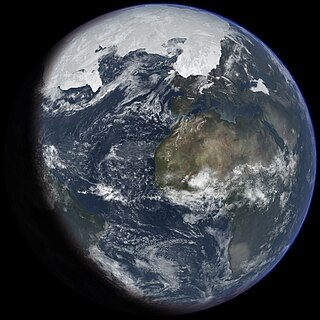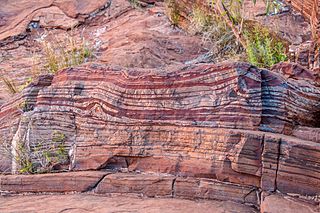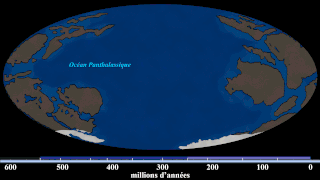Related Research Articles

The Ediacaran Period is a geological period that spans 94 million years from the end of the Cryogenian Period 635 million years ago (Mya), to the beginning of the Cambrian Period 541 Mya. It marks the end of the Proterozoic Eon, and the beginning of the Phanerozoic Eon. It is named after the Ediacara Hills of South Australia.

An ice age is a long period of reduction in the temperature of the Earth's surface and atmosphere, resulting in the presence or expansion of continental and polar ice sheets and alpine glaciers. Earth's climate alternates between ice ages and greenhouse periods, during which there are no glaciers on the planet. Earth is currently in the Quaternary glaciation, known in popular terminology as the Ice Age. Individual pulses of cold climate within an ice age are termed "glacial periods", and intermittent warm periods within an ice age are called "interglacials" or "interstadials", with both climatic pulses part of the Quaternary or other periods in Earth's history.
The Neoproterozoic Era is the unit of geologic time from 1,000 to 541 million years ago.
The Precambrian is the earliest part of Earth's history, set before the current Phanerozoic Eon. The Precambrian is so named because it preceded the Cambrian, the first period of the Phanerozoic eon, which is named after Cambria, the Latinised name for Wales, where rocks from this age were first studied. The Precambrian accounts for 88% of the Earth's geologic time.
The Snowball Earth hypothesis proposes that during one or more of Earth's icehouse climates, Earth's surface became entirely or nearly entirely frozen, sometime earlier than 650 Mya during the Cryogenian period. Proponents of the hypothesis argue that it best explains sedimentary deposits generally regarded as of glacial origin at tropical palaeolatitudes and other enigmatic features in the geological record. Opponents of the hypothesis contest the implications of the geological evidence for global glaciation and the geophysical feasibility of an ice- or slush-covered ocean and emphasize the difficulty of escaping an all-frozen condition. A number of unanswered questions remain, including whether the Earth was a full snowball, or a "slushball" with a thin equatorial band of open water.

Banded iron formations are distinctive units of sedimentary rock consisting of alternating layers of iron oxides and iron-poor chert. Almost all of these formations are of Precambrian age and are believed to record the oxygenation of the Earth's oceans.

The Proterozoic is a geological eon spanning the time from the appearance of oxygen in Earth's atmosphere to just before the proliferation of complex life on the Earth. The name Proterozoic combines the two forms of ultimately Greek origin: protero- meaning "former, earlier", and -zoic, a suffix related to zoe "life". The Proterozoic Eon extended from 2500 mya to 541 mya, and is the most recent part of the Precambrian "supereon." The Proterozoic is the longest eon of the Earth's geologic time scale and it is subdivided into three geologic eras : the Paleoproterozoic, Mesoproterozoic, and Neoproterozoic.

The Doushantuo Formation is a fossil Lagerstätte in Weng'an County, Guizhou Province, China that is notable for being one of the oldest beds to contain minutely preserved microfossils, phosphatic fossils that are so characteristic they have given their name to "Doushantuo type preservation". The formation is of particular interest because a part of it appears to cover the boundary between the enigmatic organisms of the Ediacaran geological period and the more familiar fauna of the Cambrian explosion where lifeforms recognizable as ancestors of later and recent lifeforms first emerged. Taken as a whole, the Doushantuo Formation ranges from about 635 Ma at its base to about 551 Ma at its top, predating by perhaps five Ma the earliest of the 'classical' Ediacaran faunas from Mistaken Point on the Avalon peninsula of Newfoundland, and recording conditions up to a good forty to fifty million years before the Cambrian explosion.

The Cryogenian is a geologic period that lasted from 720 to 635 million years ago. It forms the second geologic period of the Neoproterozoic Era, preceded by the Tonian Period and followed by the Ediacaran.

There have been five or six major ice ages in the history of Earth over the past 3 billion years. The Late Cenozoic Ice Age began 34 million years ago, its latest phase being the Quaternary glaciation, in progress since 2.58 million years ago.
A glacial period is an interval of time within an ice age that is marked by colder temperatures and glacier advances. Interglacials, on the other hand, are periods of warmer climate between glacial periods. The last glacial period ended about 15,000 years ago. The Holocene epoch is the current interglacial. A time with no glaciers on Earth is considered a greenhouse climate state.
The geologic temperature record are changes in Earth's environment as determined from geologic evidence on multi-million to billion (109) year time scales. The study of past temperatures provides an important paleoenvironmental insight because it is a component of the climate and oceanography of the time.
The Andean-Saharan glaciation occurred during the Paleozoic from 450 Ma to 420 Ma, during the late Ordovician and the Silurian period. For the Ordovician/Saharan part, see the more extensive article on the Late Ordovician glaciation.

The Quaternary glaciation, also known as the Pleistocene glaciation, is an alternating series of glacial and interglacial periods during the Quaternary period that began 2.58 Ma, and is ongoing. Although geologists describe the entire time period as an "ice age", in popular culture the term "ice age" is usually associated with just the most recent glacial period during the Pleistocene. Since the planet Earth still has ice sheets, geologists consider the Quaternary glaciation to be ongoing, with the Earth now experiencing an interglacial period.

Diamictite is a type of lithified sedimentary rock that consists of nonsorted to poorly sorted terrigenous sediment containing particles that range in size from clay to boulders, suspended in a matrix of mudstone or sandstone. The term was coined by Richard Foster Flint and others as a purely descriptive term, devoid of any reference to a particular origin. Some geologists restrict the usage to nonsorted or poorly sorted conglomerate or breccia that consists of sparse, terrigenous gravel suspended in either a mud or sand matrix.
Cap carbonates are layers of distinctively textured carbonate rocks that occur at the uppermost layer of sedimentary sequences reflecting major glaciations in the geological record.
The Marinoan glaciation was a period of worldwide glaciation that lasted from approximately 650 to 635 Ma during the Cryogenian period. The glaciation may have covered the entire planet, in an event called the Snowball Earth. The end of the glaciation may have been sped by the release of methane from equatorial permafrost.
The Sturtian glaciation was a glaciation, or perhaps multiple glaciations, during the Cryogenian Period when the Earth experienced repeated large-scale glaciations. The duration of the Sturtian glaciation has been variously defined,with dates ranging from 717 to 643 Ma. Stern et al. place the period at 715 to 680 Ma.
Stanley Awramik is an American biogeologist and paleontologist. He is best known for his work related to the Precambrian. In 2013, he was inducted as a fellow of the Geological Society of America.
The Smalfjord diamictite, Bigganjargga Tillite or Reusch's Moraine is a diamictite in Finnmark, northern Norway. The rock was first identified as a tillite by Hans Reusch in 1891, hence its name. The tillite overlies sandstone whose contact surface is striated. Reusch's Moraine belong to the Smalfjord Formation, a geological formation of Neoproterozoic age. The tillite possibly formed during the Sturtian glaciation in connection to a global glaciation.
References
- ↑ Macdonald, F. A.; Schmitz, M. D.; Crowley, J. L.; Roots, C. F.; Jones, D. S.; Maloof, A. C.; Strauss, J. V.; Cohen, P. A.; Johnston, D. T.; Schrag, D. P. (4 March 2010). "Calibrating the Cryogenian". Science. 327 (5970): 1241–1243. doi:10.1126/science.1183325. PMID 20203045. (Duration and magnitude are enigmatic)
- ↑ Bernhard, Joan (11 June 2013). "Insights into foraminiferal influences on microfabrics of microbialites at Highborne Cay, Bahamas". Proceedings of the National Academy of Sciences of the United States of America. 110 (24): 5. doi:10.1073/pnas.1221721110 . Retrieved 28 February 2020.
- ↑ Rooney, A. D.; Strauss, J. V.; Brandon, A. D.; MacDonald, F. A. (2015). "A Cryogenian chronology: Two long-lasting synchronous Neoproterozoic glaciations". Geology. 43 (5): 459. Bibcode:2015Geo....43..459R. doi:10.1130/G36511.1.
| This glaciology article is a stub. You can help Wikipedia by expanding it. |
